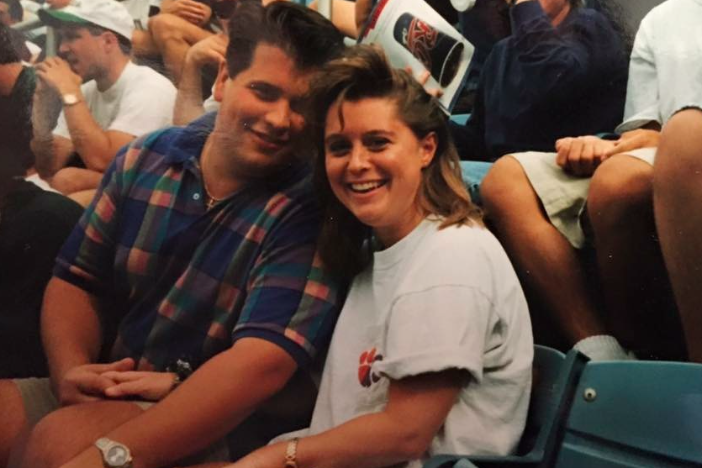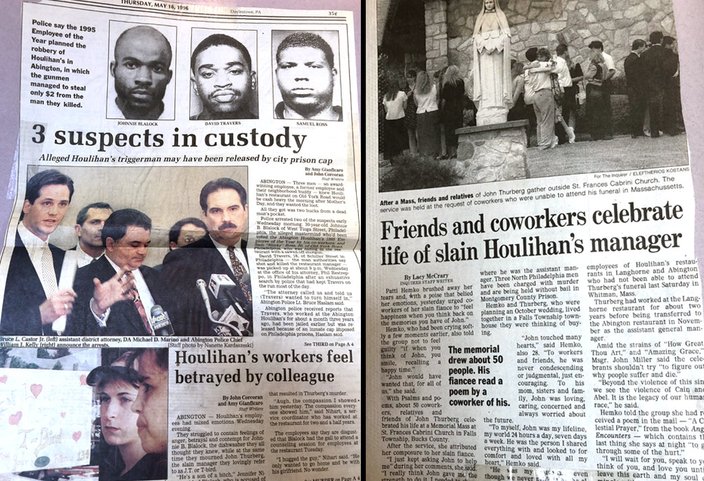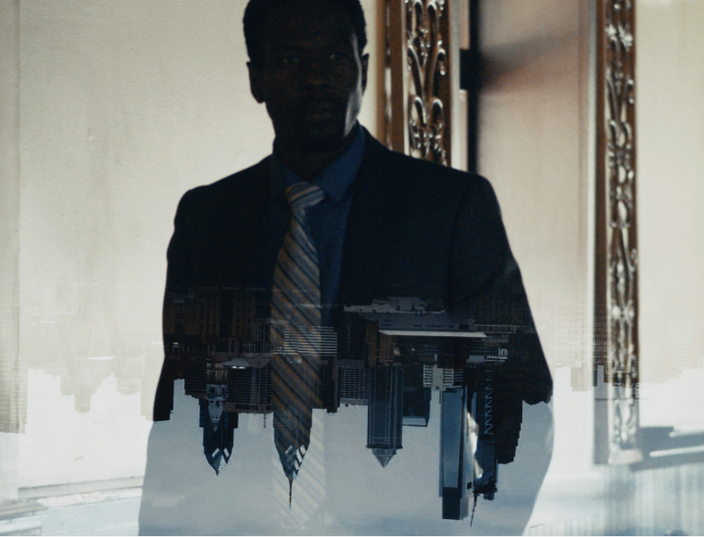
February 21, 2018
 Photo courtesy/Patti Hemko
Photo courtesy/Patti Hemko
John Thurberg and Patti Hemko were engaged to be married on Oct. 26, 1996. But a tragic crime intervened shortly after they picked out their wedding rings.
Patti Hemko and John Thurberg were just 28 years old when the life they were planning to share forever was stolen in a stomach-turning act of betrayal.
They should both be 50 today, but only Patti is alive to retell a story that shook one community to its core.
Wednesday, Patti revisited the darkest days of her life in the premiere episode of "Homicide City," an Investigation Discovery series that dusts off the files of high-profile murder cases in the Philadelphia area.
"It's still surreal after all these years," she said of the case.
Geno McDermott's Blackfin production company created the series.
"When we come up with shows like this, it's very interesting to look at communities like Abington and Malvern," he said. "On the surface, they're these kind of rich suburbs, but then we find ourselves looking at the evil behind that facade. We were noticing in Philly, as in other cities, that crime transcends socioeconomic background when it comes to murder."
John Thurberg was an assistant manager at the old Houlihan's restaurant on Old York Road in Abington – a Chili's eventually replaced it – when he was shot in the head, execution-style, during a botched robbery attempt.
It was May 13, 1996, the Monday morning after Mother's Day. John and Patti had just picked out their wedding rings at the Oxford Valley Mall. They were planning to be married in October.
Thurberg was a burly Massachusetts native and culinary grad who had hoped one day to own his own restaurant. He and Patti met in Connecticut and later moved to Langhorne, Bucks County where they worked together at a nearby Houlihan's. John, moving up the ladder, was transferred to the Abington restaurant early in 1996. His co-workers there affectionately called him J.T. and T-bird.
Mother's Day is always a major haul for the restaurant industry. When John left for work that Monday morning, he had no idea that the dishwasher, a man named Houlihan's Employee of the Year in 1995, would carry out a sinister plot to rob the cash-enriched safe at the restaurant.
In these newspaper clippings saved by Patti Hemko, the Bucks County Courier Times covered both the criminal investigation and emotional fallout in the wake of the 1996 robbery and murder at Houlihan's Restaurant in Abington.
Patti got a knock on her front door barely two hours after John drove off that morning. Just behind her, spread out on her living room couch, was her wedding dress.
It was Paul Meyers, a homicide detective with the Abington Police Department. He told Patti there had been an incident involving John. She said she wanted to go to the hospital, immediately, but Meyers and his partners explained that she couldn't.
John was dead.
The next 72 hours brought on a barrage of twists and turns in the search for truth in Thurberg's murder.
"It was just an outright inside job," said former Montgomery County Chief Detective Oscar Vance, who served the D.A.'s office for 48 years prior to his semi-retirement in 2012. Vance was an instrumental investigator in more than 800 murder cases and served as an oracle for the development of "Homicide City."
Newspaper accounts from the time of Thurberg's murder depicted a chaotic sequence of events.
Johnnie Blalock, then a 30-year-old Philadelphia resident, was the mastermind behind the robbery scheme. The beloved dishwasher, praised for his camaraderie among the staff, had stumbled upon another manager's key to the restaurant. He pocketed it and began to devise a way to rob his employer.
Investigators determined that Blalock conspired with two other Philadelphia men – David Travers, 18, and Samuel Ross, 20 – to hold up the place on that Monday morning and force Thurberg to hand over cash inside the safe.
But the crucial deception of the plan was that Blalock would feign innocence during and after the heist. He would use the key to let his conspirators into the restaurant very early that morning and lock the doors while he, Thurberg and Mark Griffin, another employee, were inside preparing for the day ahead.
"The last thing John said to his co-workers was that if he didn't make it out alive, then he wanted them to tell me he loved me and that I should do whatever I could to move forward." – Patti Hemko
Travers and Ross, both armed, hid out inside the restaurant with a very small window of time to execute the plan. Other employees were due to show up for their shifts at 8 a.m.
Ross suddenly sprung out from beneath a seating booth bearing a sawed-off shotgun.
Blalock played along – as a victim.
Thurberg engaged Ross in a struggle over the shotgun. Travers, carrying a revolver, tied up Griffin and Blalock. Eventually overtaken, Thurberg was tied up as well.
The robbery plan went awry, however, due to Blalock's ignorance of the security policy surrounding the restaurant's safe.
Houlihan's, like many restaurants, employed an armored vehicle driver to pick up money from its safe. The safe had two compartments, one requiring two keys and a second that was accessible to several members of the restaurant's management.
Thurberg told the robbers he would open up the first compartment and give them whatever was inside — as much as $10,000 in cash, it was reported. But the robbers weren't satisfied. They thought Thurberg was holding out on the larger reserve of cash in the second compartment.
"He even offered them the keys to his brand new Honda Accord," Patti said. "They wouldn't take it."
Thurberg, Blalock and Griffin were led to the bathroom and each placed inside stalls, still tied up, Patti related. Travers shot Griffin in the hands and claimed it was an accident. Then he went to Thurberg's stall, giving him one more chance. He took a measly $2 out of Thurberg's pocket — all he had on him — and then fatally shot the groom-to-be behind his right ear, killing him.
"He walked away with $2. Killed him instead of taking the money," Patti lamented. "The last thing John said to his co-workers was that if he didn't make it out alive, then he wanted them to tell me he loved me and that I should do whatever I could to move forward.
"My John died thinking that this guy, Johnnie Blalock, was a victim."
The murder of John Thurberg was featured on the front page of The Intelligencer newspaper, at left, on May 16, 1996. The Philadelphia Inquirer also covered the news story, at right.
"Being a law enforcement officer and a detective is not an easy job," Oscar Vance said. "It's not for everyone. You're often working round the clock. You just eat pizza and soda, nod out on a chair for a bit. I once worked 72 hours straight on a murder case."
Two years ago, when Vance was contacted about the development of "Homicide City," he pointed McDermott and co-producer Greg Palmer to the Thurberg murder.
"There were a lot of red herrings in that case," Vance said. "It tells the story of a murder mystery. There were some really intricate things."
In the hours after the murder, then-Deputy Montgomery County District Attorney Bruce Castor committed all of his resources to the case.
"We're handling this with the same kind of approach we take in all homicide investigations," Castor told reporters. "Complete saturation."
The day after the murder, shocked Houlihan's employees gathered to mourn their loss and receive grief counseling. Travers and Ross, who had fled the scene of the crime, were nowhere to be found. As they snuck out the back of the restaurant, the employees had stood atop the red brick landing at the front entrance, ringing the doorbell to be let inside.
Johnnie Blalock attended the grief counseling session, accepting hugs from fellow employees as they shared their compassion for him. They didn't know — and never would have guessed — that he was the one who orchestrated the robbery.
Detectives soon received a tip linking Travers to the shooting. A SWAT team corralled him at his home in Philadelphia and soon picked up on the involvement of Samuel Ross. In exchange for a third-degree murder charge, Ross told investigators that Blalock planned the robbery and Travers pulled the trigger.
"When I saw the hearse the day of John's funeral, I thought, 'This isn't supposed to be a black limo and a black dress. It's supposed to be a white limo and a white dress.'" – Patti Hemko
Blalock and Travers were sentenced to life in prison. Ross is still eligible for parole.
"Travers said he shot John because he was white," Patti recalled of the murder trial in 1997. "Ross begged me for forgiveness when he sat on the stand."
For Patti, it has been a long road to recovery from such a life-shattering experience. She was left to deal with post-traumatic stress disorder as she became the focus of an outpouring of love from community members in Abington.
"This is stuff you see on the news, not stuff that happens to you," Patti said. "When I saw the hearse the day of John's funeral, I thought, 'This isn't supposed to be a black limo and a black dress. It's supposed to be a white limo and a white dress.'"
On October 26, 1996, the day Patti and John were to be wed, she awoke at the home of friend she had moved in with after the murder. The front steps were covered with mounds of yellow roses, the same gift John would bring to show his love for her.
People from around town had picked up on the detail from their local newspapers, a testament to the strength of the community response even in those pre-internet days.
"I sometimes feel like he's going to come back and I'll hear the laugh that I remember so well," Patti said.
“Homicide City,” which airs on Investigation Discovery beginning Wednesday night, puts the spotlight on several Philadelphia-area murder cases.
With "Homicide City," McDermott and Palmer have tried to capture the complex relationship between urban environments and their surrounding suburbs.
"If we're trying to make Philly a character and have that come to life, [the viewer] has to see that many of these cases originate outside the city," Palmer said. "It gives a deeper picture of the area and it also adds intrigue."
The six-episode series lifts the sheets on the investigations into some of the region's most unsettling crimes over the past few decades. These are the headline-making cases that detectives never forget.
One episode covers the notorious Main Line murder of Courtlandt S. Gross, a retired Lockheed Aircraft Corporation chairman who was killed at his secluded mansion in 1982 along with his wife and housekeeper. The culprit, a career criminal and drifter, shrewdly kept detectives on their toes as they tried to track him down in various parts of town.
"I wanted for people to know who he was, who we were, and how senseless crime can be. I wanted people to know you can go through the most horrific, horrible thing ever, and you find a way to make it out on the other side and survive." – Patti Hemko
Another episode delves into the 2003 murder of Faina Zonis, a married mortgage processor who was part of the fabric of Northeast Philadelphia's Russian-American community. Her death, and the later suicides of the suspect's parents, sent shockwaves all the way to Russia.
"The Gross murders were really interesting to me," Palmer said. "There were so many different facets to it. It was all over the city. All of the different groups of law enforcement involved with that case helped us paint a picture of Philly. It was fascinating to hear from the detectives on all of these cases. You really learn their towns."
The making of a series like "Homicide City" necessarily requires sensitivity, the producers acknowledged. They are potentially reopening wounds by interviewing family members and recreating scenes from the crimes.
"What we try to do, it's one of those things that can go south quickly," said McDermott. "There are a lot of moments in Patti's story when we had to pick how literal we would get with our recreations. The emotion is really coming through Patti and we try to lean on that."
Patti, who is now a psychology professor and counselor at Bucks County Community College, was approached by Blackfin about a year ago. She initially thought they had questions for her based on her expertise and experience with victim's assistance and advocacy.
Instead, they revealed that they wanted to do a show about John.
"I could understand why," Patti said. "We were always portrayed as the couple next door. It struck a chord with so many people around here. Chief Vance even said that it was one of the cases that tugged the most at his heartstrings."
Vance, who continues to work in private investigations and victim therapy, said working on "Homicide City" was a pleasure, in a way.
"It was very heartwarming to see these people again," Vance said. "To hear from them and see that they're doing well."
John Thurberg would have turned 50 years old earlier this month. Patti, who later got married and divorced, still wonders how things might have been had she married the original love of her life.
"There are certain days and times it really gets to me," Patti said. "For a good three weeks after I did this [episode], it replayed in my head like a movie. It feels like he should be here again."
To overcome those moments, Patti looks at the wisdom she's been able to impart to her students.
"When I teach my classes, I use this a tool to discuss flashbacks and psychological resilience," Patti said. "My students see that if I can go through something like this and come back from it, then they should be able to find the strength to get through their own challenges."
Ultimately, Patti felt that doing the show was the best way to honor John's memory and show her appreciation for the detectives who solved the case.
"I wanted for people to know who he was, who we were, and how senseless crime can be," Patti said. "I wanted people to know you can go through the most horrific, horrible thing ever, and you find a way to make it out on the other side and survive."
When the episode premiered Wednesday night on Investigation Discovery, Patti was seeing it for the first time.
"I'll be surrounded by all of my closest friends, family and supporters," Patti said. "And a big bottle of wine."
• • •
Homicide City premiered Wednesday, Feb. 21 at 10 p.m. on Investigation Discovery. People can also watch online at IDGo.com
 Photos courtesy/Patty Hemko
Photos courtesy/Patty Hemko Photos courtesy/Patty Hemko
Photos courtesy/Patty Hemko Source/Investigation Discovery
Source/Investigation Discovery